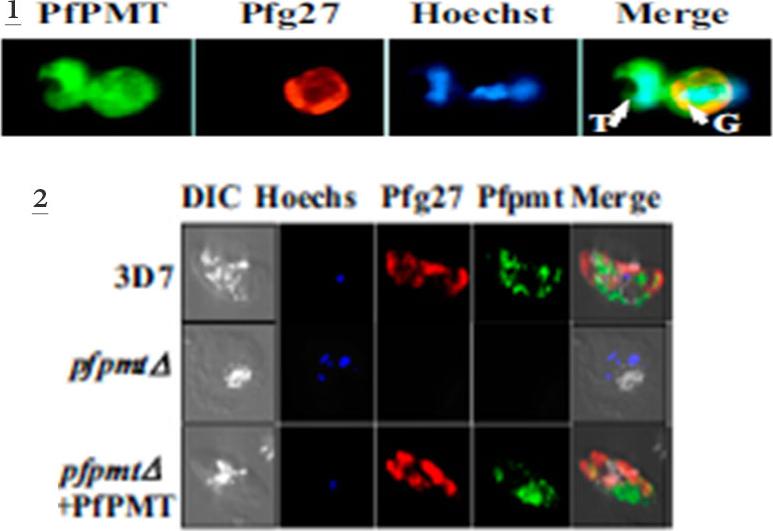PF3D7_1302100 gamete antigen 27/25 (G27/25)
Disruptability [+]
| Species | Disruptability | Reference | Submitter |
|---|---|---|---|
| P. falciparum 3D7 |
Possible |
12577051 | Theo Sanderson, Wellcome Trust Sanger Institute |
| P. falciparum 3D7 |
Possible |
10394367 \"We report successful disruption of the Pfg27 locus using homologous recombination and show that it is essential for the maintenance of the sexual phenotype. Transfectants lacking Pfg27 abort early in sexual development, resulting in vacuolated, highly disarranged, and disintegrating parasites. This suggests a critical role for Pfg27 in the sexual development of the parasite.\" |
Theo Sanderson, Francis Crick Institute |
| P. falciparum 3D7 |
Possible |
19570101 \"Disruption of several of their encoding genes so far showed that only the abundant protein Pfg27, produced at the onset of sexual differentiation, is essential for gametocyte production. In contrast with what has been previously described, here we show that P. falciparum pfg27 disruptant lines are able to undergo all stages of gametocyte maturation, and are able to mature into gametes. A fraction of Pfg27-defective gametocytes show, however, distinct abnormalities in intra- and extra-cellular membranous compartments, such as accumulation of parasitophorous vacuole-derived vesicles in the erythrocyte cytoplasm, large intracellular vacuoles and discontinuities in their trilaminar cell membrane. This work revises current knowledge on the role of Pfg27, indicating that the protein is not required for parasite entry into sexual differentiation, and suggesting that it is instead involved in maintaining cell integrity in the uniquely long gametocytogenesis of P. falciparum.\" |
Theo Sanderson, Francis Crick Institute |
Mutant phenotypes [+]
| Species | Stage | Phenotype | Reference | Submitter |
|---|---|---|---|---|
| P. falciparum 3D7 | Asexual |
No difference |
10394367 \"We report successful disruption of the Pfg27 locus using homologous recombination and show that it is essential for the maintenance of the sexual phenotype. Transfectants lacking Pfg27 abort early in sexual development, resulting in vacuolated, highly disarranged, and disintegrating parasites. This suggests a critical role for Pfg27 in the sexual development of the parasite.\" |
Theo Sanderson, Francis Crick Institute |
| P. falciparum 3D7 | Gametocyte |
Attenuated |
12577051 | Theo Sanderson, Wellcome Trust Sanger Institute |
| P. falciparum 3D7 | Gametocyte |
Attenuated |
10394367 \"We report successful disruption of the Pfg27 locus using homologous recombination and show that it is essential for the maintenance of the sexual phenotype. Transfectants lacking Pfg27 abort early in sexual development, resulting in vacuolated, highly disarranged, and disintegrating parasites. This suggests a critical role for Pfg27 in the sexual development of the parasite.\" |
Theo Sanderson, Francis Crick Institute |
| P. falciparum 3D7 | Gametocyte |
Difference from wild-type |
19570101 \"Disruption of several of their encoding genes so far showed that only the abundant protein Pfg27, produced at the onset of sexual differentiation, is essential for gametocyte production. In contrast with what has been previously described, here we show that P. falciparum pfg27 disruptant lines are able to undergo all stages of gametocyte maturation, and are able to mature into gametes. A fraction of Pfg27-defective gametocytes show, however, distinct abnormalities in intra- and extra-cellular membranous compartments, such as accumulation of parasitophorous vacuole-derived vesicles in the erythrocyte cytoplasm, large intracellular vacuoles and discontinuities in their trilaminar cell membrane. This work revises current knowledge on the role of Pfg27, indicating that the protein is not required for parasite entry into sexual differentiation, and suggesting that it is instead involved in maintaining cell integrity in the uniquely long gametocytogenesis of P. falciparum.\" |
Theo Sanderson, Francis Crick Institute |
Imaging data (from Malaria Metabolic Pathways)

1. Culture sample showing adjacent trophozoite (T)-infected erythrocytes stained with anti-PfPMT and anti-Pfg27 antibodies. both membrane and cytoplasmic localizations of the native enzyme could be detected in wild-type parasites using anti-PfPMT antibodies, suggesting that the protein might exist in both membrane-associated and soluble forms2. Immunofluorescence analysis of wild-type, pfpmtΔ and complemented pfpmtΔ+PfPMT parasites expressing PfPMT under the regulatory control of the P. falciparum CAM1 promoter. PfPMT (green), Pfg27 (red), and Hoechst (blue). No Pfg27 labeling of stage-IV or -V gametocytes could be detected in the pfpmtΔ strain, whereas stage-IV and -V gametocytes expressing both Pfg27 and PfPMT were detected in wild-type cultures.Bobenchik AM, Witola WH, Augagneur Y, Nic Lochlainn L, Garg A, Pachikara N,Choi JY, Zhao YO, Usmani-Brown S, Lee A, Adjalley SH, Samanta S, Fidock DA, Voelker DR, Fikrig E, Ben Mamoun C. Plasmodium falciparum phospho-ethanolamine methyltransferase is essential for malaria transmission. Proc Natl Acad Sci U S A. 2013 110(45):18262-7
See original on MMP
Time course analysis of PfGEXP5 expression. (b) Representative immunofluorescence images of (top panel) a ring stage-like parasite at 14 h pi positive for PfGEXP5 (green) and negative for Pfg27 (red), and (lower panel) a pigmented double-positive parasite at 38 h pi. (c) Immunofluorescence microscopy of ~18-h gametocyte and asexaul ring-infected RBCs labelled with anti-PfGEXP5 (green) and anti-RESA (red) antibodies. Brightfield images (BF) and nuclear staining are shown at right and left, respectively. Scale bar 5 μm.Tibúrcio M, Dixon MW, Looker O, Younis SY, Tilley L, Alano P. Specific expression and export of the Plasmodium falciparum Gametocyte EXported Protein-5 marks the gametocyte ring stage. Malar J. 2015 14:334. PMID:
See original on MMPMore information
| PlasmoDB | PF3D7_1302100 |
| GeneDB | PF3D7_1302100 |
| Malaria Metabolic Pathways | Localisation images Pathways mapped to |
| Previous ID(s) | PF13_0011 |
| Orthologs | |
| Google Scholar | Search for all mentions of this gene |